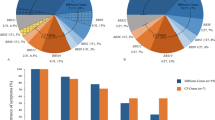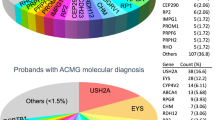Abstract
Purpose
To investigate complex and different phenotypes in seven Chinese patients diagnosed with Bardet–Biedl syndrome (BBS) and carrying pathogenic mutations.
Methods
Seven unrelated BBS patients were enrolled. Their medical and ophthalmic histories were reviewed, and comprehensive clinical examinations, such as fundus photography, optical coherence tomography, and medical imaging, were performed. A specific hereditary eye disease enrichment panel based on exome-capture technology was used to collect and amplify the protein-coding regions of 441 targeted hereditary eye disease genes, followed by high-throughput sequencing using the Illumina HiSeq platform.
Results
All patients exhibited the primary clinical phenotype of BBS. Seven BBS mutations were found in five patients (BBS7 in two patients, BBS10 in two patients, BBS12 in one patient), for a detection rate of 71% (5/7). The ratio of novel to known BBS mutations was 5:2.
Conclusions
This study showed the phenotypic and genotypic spectrum of BBS patients from China, and the findings underscore the importance of obtaining comprehensive clinical observations and molecular analyses for ciliopathies.







Similar content being viewed by others
References
Suspitsin EN, Imyanitov EN (2016) Bardet–Biedl syndrome. Mol Syndromol 7:62–71
Beales PL, Warner AM, Hitman GA et al (1997) Bardet–Biedl syndrome: a molecular and phenotypic study of 18 families. J Med Genet 34:92–98
Priya S, Nampoothiri S, Sen P et al (2016) Bardet–Biedl syndrome: genetics, molecular pathophysiology, and disease management. Indian J Ophthalmol 64:620–627
Heon E, Kim G, Qin S et al (2016) Mutations in C8ORF37 cause Bardet–Biedl syndrome (BBS21). Hum Mol Genet 25:2283–2294
Schaefer E, Stoetzel C, Scheidecker S et al (2016) Identification of a novel mutation confirms the implication of IFT172 (BBS20) in Bardet–Biedl syndrome. J Hum Genet 61:447–450
Forsythe E, Beales PL (2013) Bardet–Biedl syndrome. Eur J Hum Genet 21:8–13
Waters AM, Beales PL (2011) Ciliopathies: an expanding disease spectrum. Pediatr Nephrol 26:1039–1056
Wheway G, Nazlamova L, Hancock JT (2018) Signaling through the primary cilium. Front Cell Dev Biol 6:8
Beales PL, Elcioglu N, Woolf AS et al (1999) New criteria for improved diagnosis of Bardet–Biedl syndrome: results of a population survey. J Med Genet 36:437–446
Ullah A, Khalid M, Umair M et al (2018) Novel sequence variants in the MKKS gene cause Bardet–Biedl syndrome with intra- and inter-familial variable phenotypes. Congenit Anom (Kyoto) 58:173–175
González-Del Pozo M, Méndez-Vidal C, Santoyo-Lopez J et al (2014) Deciphering intrafamilial phenotypic variability by exome sequencing in a Bardet–Biedl family. Mol Genet Genom Med 2:124–133
Moore SJ, Green JS, Fan Y et al (2005) Clinical and genetic epidemiology of Bardet–Biedl syndrome in Newfoundland: a 22-year prospective, population-based, cohort study. Am J Med Genet A 132A:352–360
Denniston AK, Beales PL, Tomlins PJ et al (2014) Evaluation of visual function and needs in adult patients with Bardet–Biedl syndrome. Retina 34:2282–2289
Fulton AB, Hansen RM, Glynn RJ (1993) Natural course of visual functions in the Bardet–Biedl syndrome. Arch Ophthalmol 111:1500–1506
Cox GF, Hansen RM, Quinn N et al (2003) Retinal function in carriers of Bardet–Biedl syndrome. Arch Ophthalmol 121:804–810
Kim LS, Fishman GA, Seiple WH et al (2007) Retinal dysfunction in carriers of Bardet–Biedl syndrome. Ophthalmic Genet 28:163–168
Berezovsky A, Rocha DM, Sacai PY et al (2012) Visual acuity and retinal function in patients with Bardet–Biedl syndrome. Clinics 67:145–149
Azari AA, Aleman TS, Cideciyan AV et al (2006) Retinal disease expression in Bardet–Biedl syndrome-1 (BBS1) is a spectrum from maculopathy to retina-wide degeneration. Invest Ophthalmol Vis Sci 47:5004–5010
Riise R, Tornqvist K, Wright AF et al (2002) The phenotype in Norwegian patients with Bardet–Biedl syndrome with mutations in the BBS4 gene. Arch Ophthalmol 120:1364–1367
Spaggiari E, Salati R, Nicolini P et al (1999) Evolution of ocular clinical and electrophysiological findings in pediatric Bardet–Biedl syndrome. Int Ophthalmol 23:61–67
Billingsley G, Bin J, Fieggen KJ et al (2010) Mutations in chaperonin-like BBS genes are a major contributor to disease development in a multiethnic Bardet–Biedl syndrome patient population. J Med Genet 47:453–463
Deveault C, Billingsley G, Duncan JL et al (2011) BBS genotype-phenotype assessment of a multiethnic patient cohort calls for a revision of the disease definition. Hum Mutat 32:610–619
Castrosánchez S, ÁlvarezSatta M, Cortón M et al (2015) Exploring genotype-phenotype relationships in Bardet–Biedl syndrome families. J Med Genet 52:503–513
Cox KF, Kerr NC, Kedrov M et al (2012) Phenotypic expression of Bardet–Biedl syndrome in patients homozygous for the common M390R mutation in the BBS1 gene. Vis Res 75:77–87
Estrada-Cuzcano A, Koenekoop RK, Senechal A et al (2012) BBS1 mutations in a wide spectrum of phenotypes ranging from nonsyndromic retinitis pigmentosa to Bardet–Biedl syndrome. Arch Ophthalmol 130:1425–1432
Daniels AB, Sandberg MA, Chen J et al (2012) Genotype-phenotype correlations in Bardet–Biedl syndrome. Arch Ophthalmol 130:901–907
Yang L, Cui H, Yin X et al (2015) Dependable and efficient clinical molecular diagnosis of chinese rp patient with targeted exon sequencing. PLoS ONE 10:e0140684
Yin X, Yang L, Chen N et al (2016) Identification of CYP4V2, mutation in 36 Chinese families with Bietti crystalline corneoretinal dystrophy. Exp Eye Res 146:154–162
Zhang J, Wang C, Shen Y et al (2016) A mutation in ADIPOR1 causes nonsyndromic autosomal dominant retinitis pigmentosa. Hum Genet 135:1375–1387
Chen X, Zhao K, Sheng X et al (2013) Targeted sequencing of 179 genes associated with hereditary retinal dystrophies and 10 candidate genes identifies novel and known mutations in patients with various retinal diseases. Invest Ophthalmol Vis Sci 54:2186–2197
Janssen S, Ramaswami G, Davis EE et al (2011) Mutation analysis in Bardet–Biedl syndrome by DNA pooling and massively parallel resequencing in 105 individuals. Hum Genet 129:79–90
Zhou Y, Tao S, Chen H et al (2014) Exome sequencing analysis identifies compound heterozygous mutation in ABCA4 in a Chinese family with Stargardt disease. PLoS ONE 9:e91962
Qi Z, Shen Y, Fu Q et al (2017) Whole-exome sequencing identified compound heterozygous variants in MMKS in a Chinese pedigree with Bardet–Biedl syndrome. Sci China Life Sci 60:739–745
Shen T, Shou T, Lin KQ et al (2011) Establishment of B lymphoblastoid cell lines of Miao pedigree with Bardet–Biedl syndrome. Chin J Med Genet 28:33–36
Shen T, Gao JM, Shou T et al (2019) Identification of a homozygous BBS7 frameshift mutation in two (related) Chinese Miao families with Bardet–Biedl Syndrome. J Chin Med Assoc 82:110–114
Khan SA, Muhammad N, Khan MA et al (2016) Genetics of human Bardet–Biedl syndrome, an updates. Clin Genet 90:3–15
Klink BU, Zent E, Juneja P et al (2017) A recombinant BBSome core complex and how it interacts with ciliary cargo. Elife 6:e27434
Blacque OE, Reardon MJ, Li C et al (2004) Loss of C. elegans BBS-7 and BBS-8 protein function results in cilia defects and compromised intraflagellar transport. Genes Dev 18:1630–1642
Zhang Q, Nishimura D, Vogel T et al (2013) BBS7 is required for BBSome formation and its absence in mice results in Bardet–Biedl syndrome phenotypes and selective abnormalities in membrane protein trafficking. J Cell Sci 126:2372–2380
Zhang Q, Yu D, Seo S et al (2012) Intrinsic protein-protein interaction-mediated and chaperonin-assisted sequential assembly of stable Bardet–Biedl syndrome protein complex, the BBSome. J Biol Chem 287:20625–20635
Ohto T, Enokizono T, Tanaka R et al (2017) A novel BBS10 mutation identified in a patient with Bardet–Biedl syndrome with a violent emotional outbreak. Hum Genome Var 4:17033
Cognard N, Scerbo MJ, Obringer C et al (2015) Comparing the Bbs10 complete knockout phenotype with a specific renal epithelial knockout one highlights the link between renal defects and systemic inactivation in mice. Cilia 4:1–12
ÁlvarezSatta M, Castrosánchez S, Pereiro I et al (2014) Overview of Bardet–Biedl syndrome in Spain: identification of novel mutations in BBS1, BBS10 and BBS12 genes. Clin Genet 86:601–602
Seo S, Baye LM, Schulz NP et al (2010) BBS6, BBS10, and BBS12 form a complex with CCT/TRiC family chaperonins and mediate BBSome assembly. Proc Natl Acad Sciences USA 107:1488–1493
Álvarez-Satta M, Castro-Sánchez S, Valverde D (2017) Bardet–Biedl syndrome as a chaperonopathy: dissecting the major role of chaperonin-like BBS proteins (BBS6-BBS10-BBS12). Front Mol Biosci 4:55
Shin SJ, Kim M, Chae H et al (2015) Identification of compound heterozygous mutations in the BBS7 gene in a Korean family with Bardet–Biedl syndrome. Ann Lab Med 35:181–184
Billingsley G, Deveault C, Héon E (2011) BBS mutational analysis: a strategic approach. Ophthalmic Genet 32:181–187
Molday RS (2015) Insights into the molecular properties of ABCA4 and its role in the visual cycle and stargardt disease. Prog Mol Biol Transl Sci 134:415–431
Sabirzhanova I, Lopes PM, Rapino D et al (2015) Rescuing trafficking mutants of the ATP-binding cassette protein, ABCA4, with small molecule correctors as a treatment for stargardt eye disease. J Biol Chem 290:19743–19755
Westerfeld C, Mukai S (2008) Stargardt’s disease and the ABCR gene. Semin Ophthalmol 23:59–65
Molday RS, Zhong M, Quazi F (2009) The role of the photoreceptor ABC transporter ABCA4 in lipid transport and Stargardt macular degeneration. Biochim Biophys Acta 1791:573–583
Funding
This study was supported by a grant from the National Natural Science Foundation of China (No. 81271046).
Author information
Authors and Affiliations
Corresponding author
Ethics declarations
Conflict of interest
The author declares that they have no competing interest.
Additional information
Publisher's Note
Springer Nature remains neutral with regard to jurisdictional claims in published maps and institutional affiliations.
Rights and permissions
About this article
Cite this article
Tao, T., Wang, L., Chong, W. et al. Characteristics of genotype and phenotype in Chinese patients with Bardet–Biedl syndrome. Int Ophthalmol 40, 2325–2343 (2020). https://doi.org/10.1007/s10792-020-01415-3
Received:
Accepted:
Published:
Issue Date:
DOI: https://doi.org/10.1007/s10792-020-01415-3




